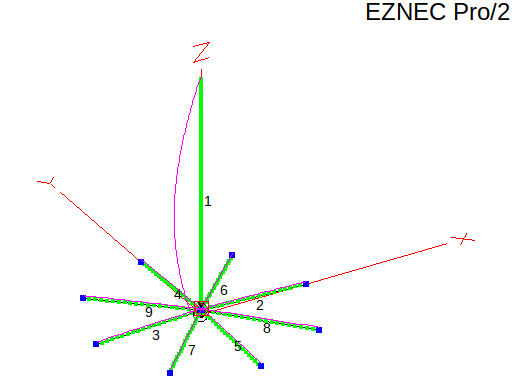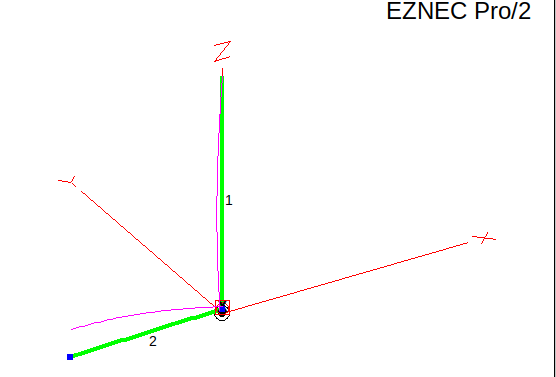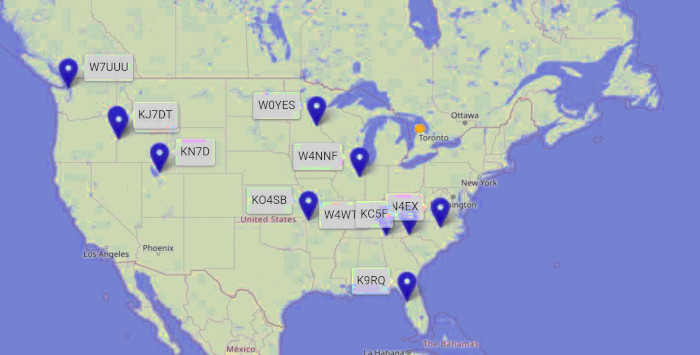If you follow the advice often repeated on Internet forums you will learn that to make a vertical antenna as efficient as possible you will need as many radials as possible. After all, the AM broadcasters can’t be wrong – they use hundreds of radials at the base of their towers.
That advice may be correct for a permanent installation, but a field expedient temporary antenna follows a different rulebook. I have been using just four radial wires at the base of my vertical antennas when operating out in the field. Yes, it may be less efficient than a whole rat’s nest of wire surrounding the antenna but “field expedience” is the key issue for portable operations.
Recently I contemplated doubling the number of radials around my field antennas. With a little bit of ingenuity I discovered I could lay down 8 radials in not much more time than it took to spread out just 4.
Then I read an interesting post on the HFpack forum. HFpackers operate while walking – their entire station carried on their backs. What do they do about “the other half” of their shortened, pack-mounted vertical antenna? They use a drag wire that literally drags along the ground as they walk. The post I read highlighted that the drag wire creates a directional propagation pattern with some gain in the direction of the wire.
Neurons in my brain started firing on all cylinders; I had an idea. Could the concept of creating a directional antenna, using just a single radial wire be optimized? Lets examine that idea.
Here is the EZNEC representation of my Rybakov (28.5ft vertical random wire) antenna with 8 radials:

And here is the predicted propagation pattern from that antenna:

As you can see, the propagation pattern is omnidirectional and the gain is effectively zero. This would be a good antenna for many hams, but maybe not for everybody. If you are activating a Park or a summit near the east or west coast, most of your hunters will be in the opposite direction. If you are in the east then sure, you might snag some European stations (I have on many occasions) but the majority of your hunters will be north, south and west of your operating site.
My home QTH is southern Ontario, Canada. Most Canadians live within 100km of the border with the United States. That means, for us, there isn’t much to the north except bears, rattlesnakes and billions of trees. What point, then, to waste my signal by propagating it over the North Pole? Better, by far, to focus my signal towards where it will encounter the greatest concentration of hunters – the eastern states south of the Canada/US border.
Here is an EZNEC model of the same Rybakov vertical random wire antenna, but this time with just a single ground-mounted radial wire:

And here is EZNEC’s model of the predicted propagation pattern:

Take a look at the gain now, 4.23dB. That’s not quite a full S-unit, but that doesn’t tell the full story. Most of my signal is now being propagated in the direction in which the radial is oriented. The beamwidth is over 80 degrees, so if I orient my radial wire toward the southwest I can target the whole of the lower 48 states. I should add that changing the length of the radial impacts both the gain and the propagation pattern. I could squeeze a little more gain by increasing the radial wire length, but the pattern begins to distort so I settled on 18.5 feet. Note that this report is all based on the 20m band.
Interesting theory, but can it work in the field or is big disappointment in store when I discover than 8 radials really are way better than 1 after all? Only one way to find out, so I loaded my field portable kit into the truck and set up my station at the Ainslie Wood Conservation Area on the eastern shore of Owen Sound Bay (part of Georgian Bay, which in turn is part of Lake Huron) Ontario. Ainslie Wood is a POTA entity: VE-5006.
My first contact was KN7D in Utah. That was encouraging, but then my second contact had me scratching my head in confusion. F5UQE in France came in at a very strong 599 and gave me a report of 529. Just a moment I thought, yes it was nice to put another DX station in the log, but it didn’t fit the pattern. Later, when I consulted an azimuthal map (courtesy of Tom, NS6T) centered on my location, I realized the French station was either catching me on the long path, or was hearing me off the back of my antenna.
The remainder of my contacts from that activation can be seen in the map below. My station, 200km northwest of Toronto is marked with the colored dot (N.B. F5UQE is not shown):

My radial wire was oriented southwest and the expected propagation pattern was verified. I had good coverage all the way from the US east to the west. My final contact was another POTA activator, W7UUU in Washington state. I called him several times but he couldn’t hear me, so I tried re-orienting the radial to face west. It worked, he came back to me with a 559 report on my 20 watts CW signal. The distance between us is over 4000km (2500 miles).
Based on a single activation it seems that 1 radial may be “better” than 8. It is certainly not a scientifically valid conclusion. Of course, “better” is a subjective conclusion anyway. A station in the midwest states may find omnidirectional propagation “better”.
A few days later I set up the same station in my backyard to hunt some stations participating in the International Lighthouses and Lightships Weekend (ILLW). I am primarily a CW operator so I searched the CW portion of 20m first, but without any luck. Then I moved up the band to the SSB portion and heard a station in Prince Edward Island, Canada calling CQ. I scrambled to dig a microphone out of the deep, dark vaults of my shack and hurried back to my radio.
Cranking the power up to a dizzying, battery-draining 50 watts I waited for the station to call CQ again and threw out my callsign. There was silence for a few seconds before the PEI station came back on the air and said: “I’m sorry you’re down in the noise; I can’t pull out your callsign, please try again”. I tried again but same result. The I realized my single radial wire was pointing south where I expected to have the best chance of hearing ILLW operators. Prince Edward Island (PEI) is about 1300km (800 miles) to my east. I sprang out of my chair and moved the radial to face directly east, then called again. This time the station came back to me right away with a 56 report and I was in his log.
So is 1 radial better than 8? I had good results with this arrangement in these example situations. My conclusion is that “as many radials as possible” is sound advice for a permanent installation, but even then, antenna performance may benefit from orienting the radials toward your preferred direction of propagation. Those of us who operate primarily in the field with rapidly deployable temporary antennas can experiment and take advantage of the ability to quickly change the direction of our signal’s radiation.
Hi John,
As always an interesting story.
It would have been great on the first test if you had used both the single counterpoise wire and your set of 8 radials on the same activation from Ainslie Wood. Then if you got the same distances to the Southwest plus some other stations in other directions, you may have concluded otherwise.
The second test, however, is more interesting – same station and “rotate” the counterpoise and it made a difference.
I wonder if the next step to this would be to fit a multiway wafer switch at the base of the vertical so that you can select each of the 8 radials in turn, or short them all together and see which gave the best-received signal? If that does “steer” the antenna – then the switch would need to be replaced with a set of relays so that you could “turn” the antenna from the operating position.
73 Ed.
LikeLike
Thanks for the comment Ed. I really like your idea of using a switch to select different radials. In my situation I could maybe use my existing 4 radials pointing N, S, E and W. I could then quickly change the directionality of the antenna to compare results. I am thinking of perhaps a switchbox with 4 toggle switches and some arrangement to short them all for omnidirectional propagation. Since my beam width is nearly 90 degrees I probably wouldn’t need 8 individual radials.
LikeLike
I look at your antenna model gains of 4.23 dBi vs minus 0.26 dBi and wonder why you wonder which is better.
If directionality and gain are of interest then one radial is better.
My experience with the single-radial (bent dipole) on my motorhome says a solid contact can barely hear me if I rotate the antenna around to the back of the L.
If an omnidirectional signal is important then two or more radials is better. This is what I use at home for 17 meters. Here is my modeling for 1,2,3,4,6 and 8 radials:
https://www.qsl.net/kk4obi/Elevated%20Radials.html
In sunmmary:
The ratio of vertical to radial can vary from the usual 50-50 to as much as 74-25.
If the vertical is taller the antenna is more vertical-like is the performance.
The shorter the the vertical the more dipole-like (broadside gain) is the performance due to the long side element.
Resonance is tuned by the total length of vertical plus radial. The more radials the shorter the total length to achieve resonance.
SWR is tuned by the angle of radial(s). Impedance goes down as radial angle goes from angled (50-50 L) to horizontal (tall or short L).
LikeLike
Thanks for your comment Dick. Your website is a treasure trove of valuable information; great Job! Re: “I look at your antenna model gains of 4.23 dBi vs minus 0.26 dBi and wonder why you wonder which is better.” The gain is only useful in the direction the radial is pointing. A station calling from the opposite direction will be nearly 2 S-units down.
LikeLike
Well, John, nothing really new with your one radial/counterpoise vertical. Those of us who have used a Buddipole vertical for the last 10 years or so know that a one-radial/counterpoise vertical configuration is somewhat directional. I overcome that by putting up three or four and generally get an omni-directional signal. Now Buddipole verticals are usually elevated (about 8-feet or so) as are the radial/counterpoise (same height, and slope to about one meter off the ground). You should try two, three or four radials pointing in your favorite directions and see what happens. Oh, I’m not a big fan of antenna modeling. The proof is in the actual performance on the ground!
GL,
Rich, KA2VCW
LikeLike
Thanks for your thoughts Rich. I agree with you about modeling; you can’t beat actual field results. I use EZNEC to get an idea of what might work in the field. Unfortunately I have to run EZNEC under Wine on my Linux PC. Wine corrupts a lot of the useful information.
LikeLike
Know what you mean…I am a Mac op and try using those on HAM radio! I declared defeat and purchased a Windows mini computer. It runs ok (I’m an ex-systems app specialist, so I have some Windows and Linux experience). I am presently building a quarter-wave vertical with raised counterpoises — ala Buddipole. It will be on a 7-meter Spiderbeam pole and the counterpoises about a meter off the ground. More permanent than a Buddipole. I may even try a 20-meter half square with a pair of Spiderbeam poles. Antennas will be the death of me!
LikeLike
Ha, good luck! BTW, I just completed a POTA activation with a 1/4w whip, 4 radials oriented south. Contacts mostly western states plus UK and Italy. I’ll model it later to see what the computer says.
LikeLike
Where did you get your “Wireless Wagon” ? Or, who makes it? I’d really like to have a ‘hand truck’ with the large diameter wheels like that. Google can’t find me even one.
LikeLike
Thanks for the question Doug. I built it myself. In fact I have built two of them; one with 1 wheel and another with 2 wheels. I used wheels from a hand-pulled golf cart for the 2-wheel version and a child’s bicycle wheel for the 1-wheel version. I scavenged the metal tubing from an old baby stroller I bought at a charity store. They are available commercially, e.g. https://gearjunkie.com/outdoor/mule-backpack
LikeLike